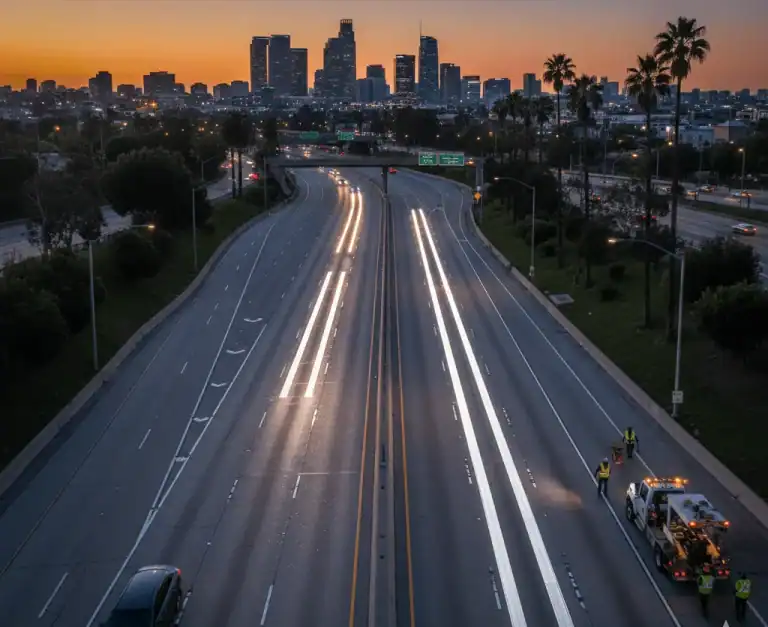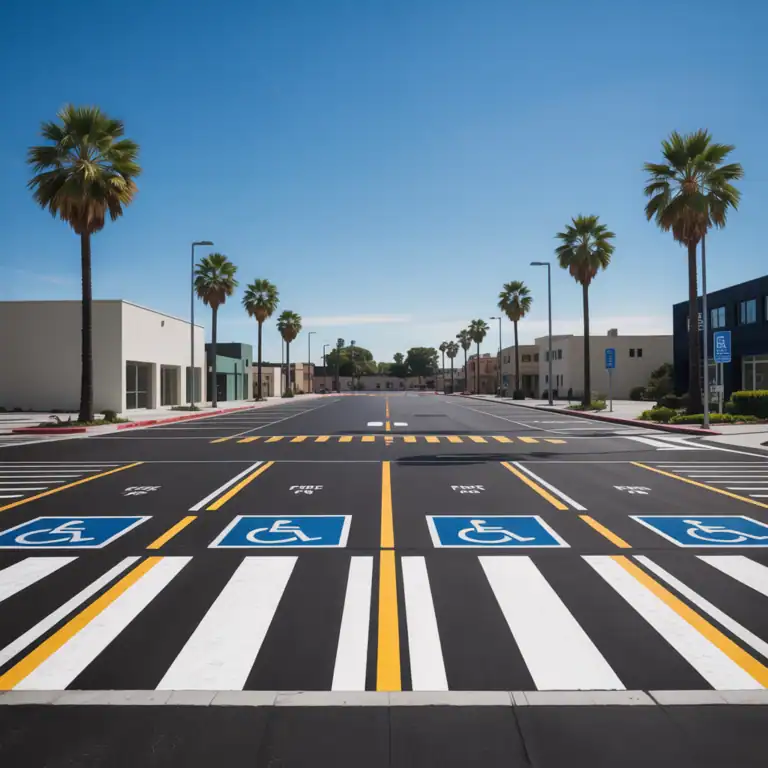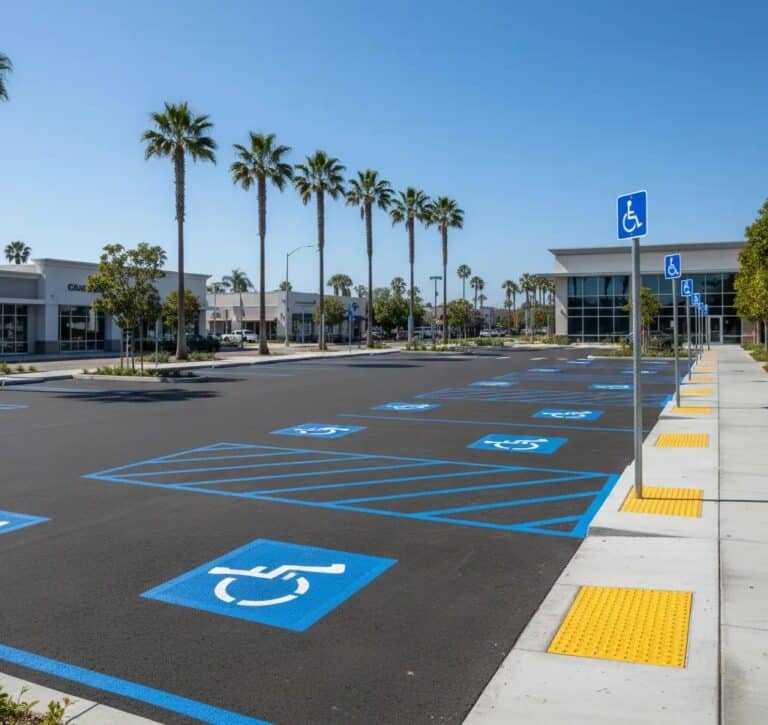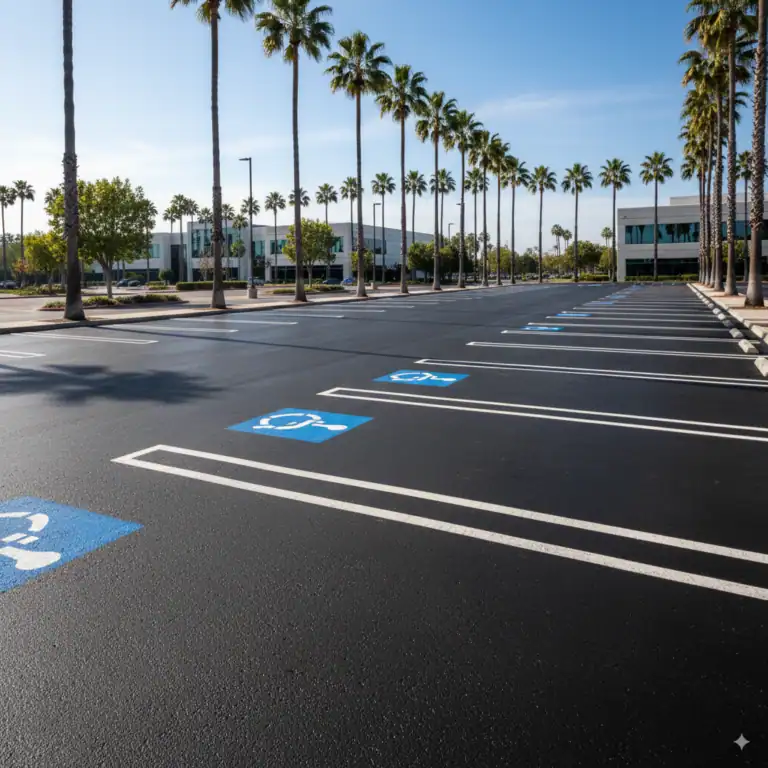Highway striping keeps roads safe and organized. It guides drivers through busy freeways like I-5, I-10, and I-405 in Los Angeles, where millions of cars travel daily. Over 400 million vehicle miles are driven in LA County every day, and clear lines prevent accidents and keep traffic moving. LA’s intense sun, smog, and occasional rain wear down markings fast, so choosing the right materials and methods matters.
This guide explains highway striping Los Angeles in simple terms for property managers, business owners, contractors, and government agencies. We cover materials like paint and thermoplastic, how they’re applied, costs, and rules like Caltrans and ADA standards. You’ll learn how striping works, why it’s important, and how to avoid problems like faded lines or fines. Think of this as your roadmap to safer, better roads.
By the end, you’ll understand:
- How striping makes roads safer and smoother.
- Which materials last longest in LA’s tough climate.
- How to meet Caltrans, MUTCD, and ADA rules.
- What challenges LA’s weather and traffic create.
- How to pick a contractor for lasting results.
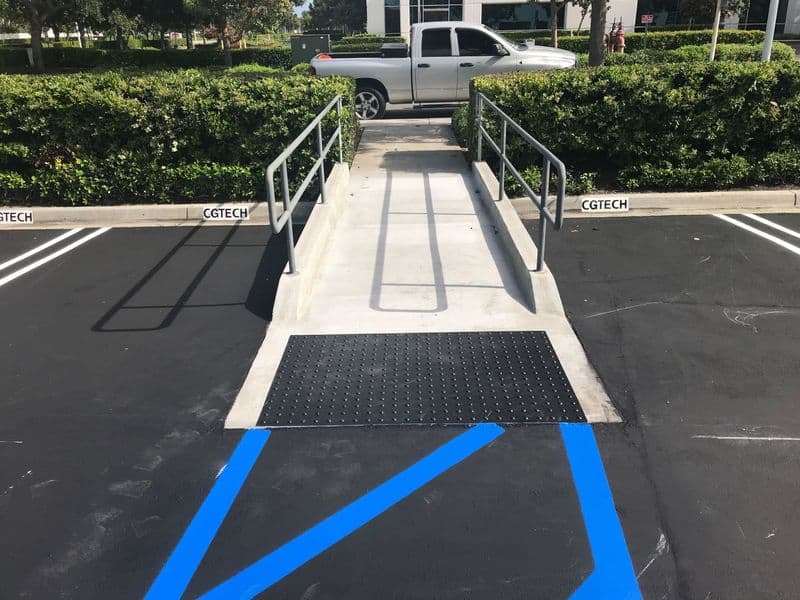
Why Highway Striping Matters in Los Angeles
Striping isn’t just lines on pavement. It saves lives, reduces traffic jams, and keeps you compliant with strict rules. In Los Angeles, heavy traffic and harsh weather make it even more critical.
Safety Benefits
Clear lines help drivers stay in their lanes, especially at night or in rain. A 2023 Caltrans study shows good striping cuts nighttime crashes by 30% on roads like I-405. Reflective glass beads bounce headlights back, making lines visible in smog or drizzle.
For example, on I-5, double yellow lines stop unsafe passing, preventing head-on crashes. About 20% of LA freeway accidents come from lane drift, and proper pavement delineation lowers that risk. Rumble strips, like those on I-10 shoulders, vibrate to wake distracted drivers.
Traffic Flow and Efficiency
LA drivers spend 81 hours a year stuck in traffic, per a 2024 INRIX report. Clear lane markings keep drivers organized, reducing chaos at busy spots like I-10 exits. Exit-only striping stops last-second lane switches, easing jams.
At freeway splits, like I-5 and I-10, gore point markings guide cars smoothly, cutting delays by up to 10%, says a 2024 LADOT study. Good striping is like a traffic cop, keeping LA’s freeways flowing.
Legal and Compliance Importance
Los Angeles follows strict Caltrans, MUTCD, and ADA rules. If your striping doesn’t meet standards, you could face $4,000 fines per violation, especially for ADA issues like accessible parking. Caltrans checks line widths, colors, and reflectivity to ensure safety. Mess up, and your project could be delayed or need costly fixes. Compliance keeps roads safe and avoids legal headaches for agencies and contractors.
Local Statistics
LA County’s 7 million vehicles make roads like I-5, with 200,000 daily cars, some of the busiest in the U.S. A 2024 LADOT report says 15% of accidents tie to faded or unclear lines. LA’s hot sun and heavy traffic wear markings down fast, so regular upkeep is a must to keep drivers safe.
Types of Highway Markings and Their Functions
Each type of marking has a job, from guiding traffic to warning drivers. Knowing these helps you see why they’re vital for LA’s roads.
Standard Road Markings
- Center Lines: Yellow lines split traffic going opposite ways. On I-5, double yellow stripes mean no passing unless broken.
- Lane Markings: White pavement markings separate lanes going the same way, keeping I-405 orderly.
- Edge Lines: White or yellow pavement markings show road edges, crucial on dark I-10 stretches.
- Broken Lines vs. Solid Lines: Broken lines allow passing; solid lines don’t, reducing risks on busy roads.
Special Markings
- Elephant Tracks: Wide, white stripes at ramps, like I-110 exits, slow cars for safety.
- Gore Points: Triangular markings at splits, like I-5/I-10, guide cars to the right lane.
- Exit-Only Striping: Dotted lines mark dedicated exit lanes, cutting confusion at interchanges.
- Channelization: Markings funnel traffic into paths, key for LA’s tricky freeway junctions.
Safety Enhancements
- Highway Rumble Strips: Grooves on I-5 shoulders vibrate to alert drifting drivers.
- Raised-Profile Markings: Bumpy lines stay visible in rain, great for LA’s wet months.
- Inverted-Profile Markings: Lines set into pavement last longer on busy roads like I-405.
Color Coding in Los Angeles
MUTCD rules say yellow splits opposing traffic, white guides same-direction lanes, red marks stop lines, and blue shows accessible parking. LA sticks to these for clear, safe driving.
[Table Suggestion: Marking Type | Function | Los Angeles Example]
| Marking Type | Function | Los Angeles Example |
| Double Yellow | Stops passing | I-5 near Downtown |
| White Lane Lines | Separates lanes | I-405 through Sepulveda Pass |
| Elephant Tracks | Slows ramp traffic | I-110 exits |
| Rumble Strips | Alerts drifting drivers | I-10 shoulders |
Highway Striping Materials in Los Angeles
Choosing the right material keeps lines visible and durable in LA’s tough conditions. Each has pros and cons.
Paint Options
- Waterborne Paint: Eco-friendly and cheap, but fades in 6 to 12 months under LA’s sun and traffic. Good for quiet roads.
- Solvent-Borne Paint: Lasts longer than waterborne but has high VOCs, so it’s limited by LA’s green rules.
- Two-Component Paint: Mixes resin and hardener for better shine, used in temporary work zone striping.
Durable Materials
- Thermoplastic Striping: Melted onto pavement, it lasts 2 to 4 years on busy freeways like I-405. It fights UV fading better than paint.
- Epoxy Pavement Markings: A tough, two-part mix lasts 3 to 5 years, perfect for I-10’s heavy traffic.
Tapes and Additives
- Preformed Tape: Sticky, pre-cut strips for quick use in construction zones.
- Reflective Tape: Boosts visibility for short-term projects on I-5.
- Glass Beads: Tiny beads in paint or thermoplastic reflect headlights.
- High-Performance Glass Beads: Bigger Type 2 glass beads shine brighter in rain, meeting Caltrans rules.
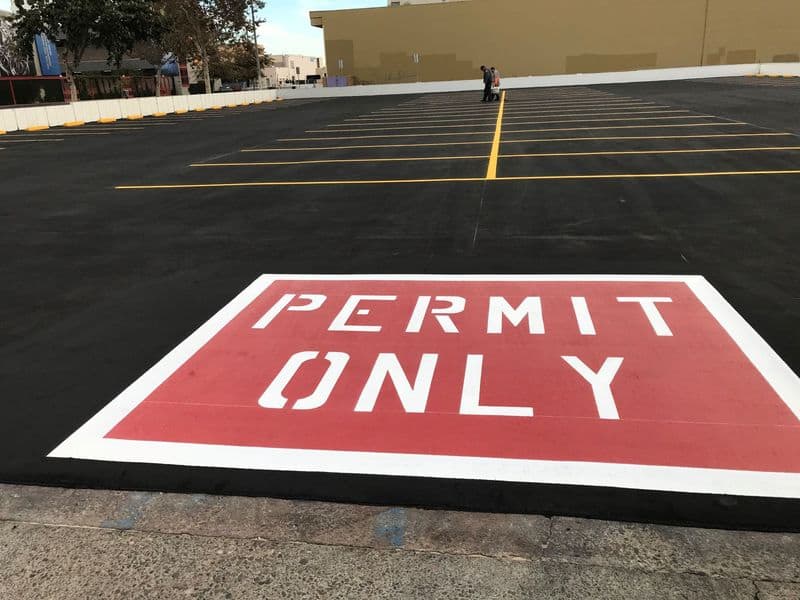
Retroreflective Technologies
Retroreflective materials make lines glow under headlights, key for LA’s rainy nights. Glass beads hit 300 to 500 mcd/lx/m² reflectivity, and Type 2 beads boost wet visibility by 20%, per a 2024 FHWA study. Better beads mean less frequent repainting, saving time and money.
| Material | Lifespan | Cost (per linear foot) | Best Use Case |
| Waterborne Paint | 6 to 12 months | $0.10 to $0.20 | Quiet roads |
| Thermoplastic | 2 to 4 years | $0.50 to $1.50 | Busy freeways |
| Epoxy | 3 to 5 years | $0.75 to $2.00 | Long-term projects |
| Reflective Tape | 1 to 2 years | $1.00 to $3.00 | Construction zones |
Highway Striping Techniques
Applying stripes takes skill and the right tools, especially in LA’s busy and hot conditions.
Application Methods
- Extrusion Striping: Hot thermoplastic is pushed onto pavement, making tough lines for I-5.
- Spray Application: Paint sprayed fast for big jobs, but less durable.
- Airless Striping: Gives even lines, great for freeways.
- Atomizing Striping: Fine spray for precise lines in city areas.
Specialized Equipment
- Mobile Striping Equipment: Trucks cover long stretches like I-405 fast.
- Portable Striping Equipment: Handheld tools work for small, detailed jobs like gore point markings.
Advanced Techniques
- Recessed Markings: Lines set in pavement grooves last longer against traffic wear.
- Inlay Markings: Thermoplastic pressed into new asphalt sticks better.
- Profile Thermoplastics: Bumpy lines shine in rain, good for LA’s wet seasons.
Surface Preparation
Pavement grinding clears old lines. Heating pavement to 70°F stops cracks. Clean, dry surfaces help glass bead embedment for better shine. Poor prep means lines peel or fade fast.
[Diagram Suggestion: Show extrusion striping on I-5]
Want to make your highways safer and compliant? Reach out to a trusted highway striping company Los Angeles like ADA Striping in Huntington Beach, CA, for a free consultation.
Safety and Compliance Standards in Los Angeles
LA’s highways must follow strict rules to keep drivers safe and avoid fines.
Caltrans Specifications
Caltrans demands 4 to 6-inch lines, 150 to 250 mils thickness, and 300 mcd/lx/m² reflectivity. Colors must match MUTCD standards. Mistakes mean rejected projects or costly fixes.
MUTCD Guidelines
MUTCD sets national rules for traffic striping, like 10-foot broken lines with 30-foot gaps. This keeps LA drivers clear on rules, reducing accidents.
ADA Compliance
Accessible parking and ramps need proper striping, or you risk $4,000 fines per violation. This is a big deal for LA’s commercial and public spaces.
AASHTO Standards
AASHTO guides federal projects like I-10, focusing on durable, visible road surface marking. These rules ensure lines last under heavy traffic.
[Checklist Suggestion: Caltrans/MUTCD Compliance]
- Lines: 4 to 6 inches wide
- Reflectivity: 300 mcd/lx/m² or higher
- Bead embedment: At least 60%
- Colors: Yellow/white per MUTCD
Cost of Highway Striping in Los Angeles
Striping costs depend on materials, traffic, and prep work in LA’s unique setting.
Cost Factors
- Materials: Thermoplastic striping ($0.50 to $1.50 per foot) costs more than waterborne paint ($0.10 to $0.20).
- Traffic: Night work on I-405 raises labor costs due to lane closures.
- Prep: Pavement surface preparation like grinding adds $0.05 to $0.10 per foot.
- Equipment: Big trucks cost more than small tools.
Price Ranges
- Per Linear Foot: Paint ($0.10 to $0.20), thermoplastic ($0.50 to $1.50), epoxy ($0.75 to $2.00).
- Per Lane Mile: Paint ($1,000 to $2,000), thermoplastic ($5,000 to $10,000), epoxy ($7,000 to $15,000).
Long-Term Savings
Thermoplastic striping lasts 2 to 4 years, while paint fades in 6 to 12 months. A 2024 LADOT study says thermoplastic saves 30 to 40% over five years on I-5 by cutting repainting needs.
| Material | Cost/Linear Foot | Lifespan | Savings Over 5 Years |
| Paint | $0.10 to $0.20 | 6 to 12 months | Minimal |
| Thermoplastic | $0.50 to $1.50 | 2 to 4 years | 30 to 40% |
| Epoxy | $0.75 to $2.00 | 3 to 5 years | 25 to 35% |
Highway Striping Process Step-by-Step
Striping follows a clear process to ensure quality and meet rules.
- Site Inspection and Surface Preparation: Check pavement and clean or grind it.
- Planning and Layout: Set up traffic control devices to map lines per Caltrans.
- Application of Markings: Apply traffic paint or thermoplastic with spray or extrusion.
- Glass Bead Embedment: Add beads for reflectivity during application.
- Drying and Curing Time: Paint dries in 5 to 10 minutes, thermoplastic in 15 to 20, epoxy in 20 to 30.
- Compliance Inspection: Check lines for width, shine, and MUTCD rules.
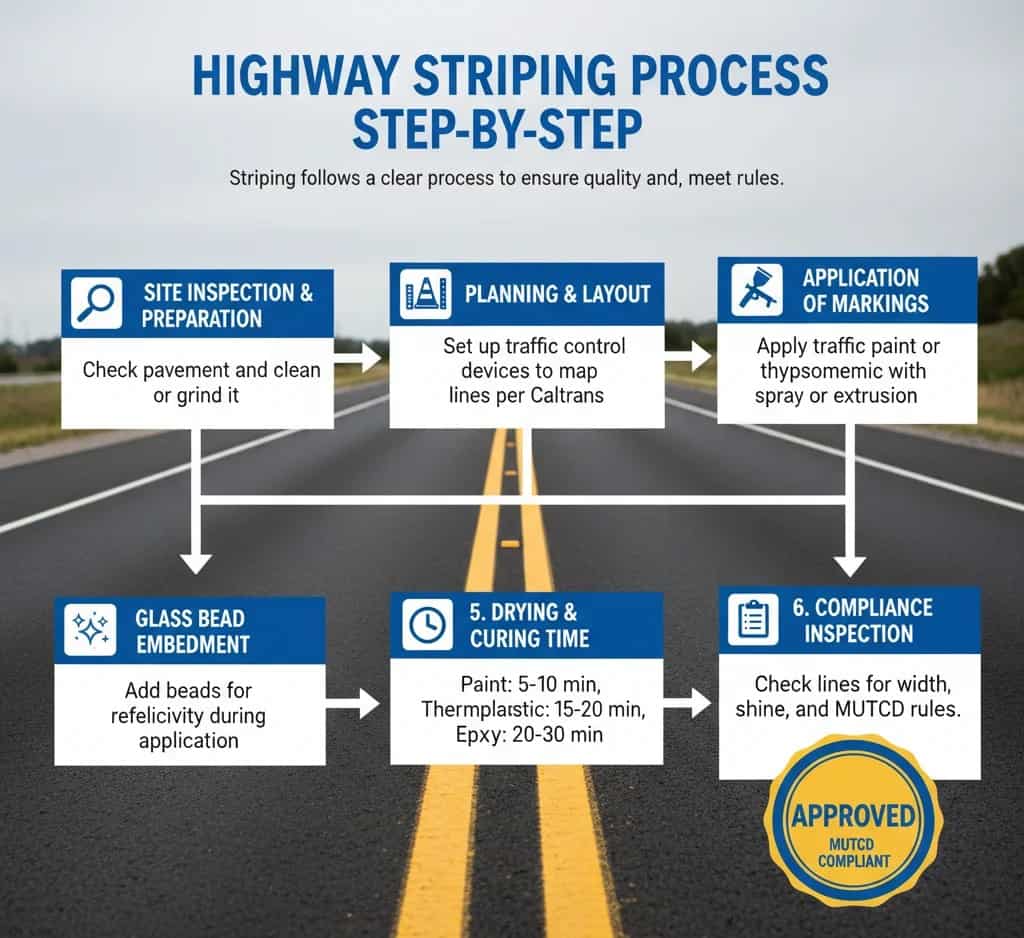
Highway Maintenance and Restriping in Los Angeles
Regular upkeep keeps LA’s markings clear and compliant.
Lifespan by Material
- Waterborne Paint: 6 to 12 months, fading fast under sun and traffic.
- Thermoplastic Striping: 2 to 4 years, good for I-405’s heavy use.
- Epoxy Pavement Markings: 3 to 5 years, tough on I-10.
Common Issues
- Fading: Sunlight fades traffic paint in 6 to 8 months.
- Cracking/Peeling: Bad prep makes thermoplastic peel.
- Snowplow Damage: Rare in LA but hurts recessed markings.
- Traffic Paint Debonding: Oil or water weakens paint grip.
Restriping Frequency
Busy I-5 needs paint every 6 to 12 months, thermoplastic every 2 to 3 years, and epoxy every 3 to 5 years. Quieter roads can wait longer.
Stripe Removal Methods
- Pavement Grinding: Clears lines without harming pavement.
- Blasting: Uses water or sand for tough pavement marking removal.
- Chemical Removal: Rare due to LA’s eco rules.
Challenges of Highway Striping in Los Angeles
LA’s unique conditions make striping tricky but manageable with the right approach.
Heat and UV Exposure
Temps over 90°F and strong UV fade solvent-borne paint in 6 to 8 months. Thermoplastic striping can soften above 120°F, so crews work at night.
Heavy Traffic
I-405’s traffic limits work to 10 PM to 5 AM, raising costs for temporary markings and closures. Heavy use wears lines faster, needing tougher materials.
Weather Conditions
Rain delays cure time; humidity messes with adhesion. Crews avoid LA’s wet season (December to March) for best results.
Budget and Contractor Issues
Some highway striping contractors Los Angeles skip prep or use cheap materials, causing lines to fail early. Hidden costs can spike budgets by 20%, per a 2024 Caltrans report.
Future of Highway Striping in Los Angeles
New ideas are making striping tougher and smarter for LA’s roads.
Environmentally Friendly Options
Low-VOC waterborne paint and green thermoplastic striping cut emissions to meet LA’s eco goals.
Smart Highways
Highway signs and markings readable by self-driving cars are being tested on I-10. AI could adjust lines based on traffic patterns.
Advanced Reflectivity
Glow-in-the-dark paints and solar coatings improve visibility by 20%, per a 2025 FHWA study, great for LA’s rainy nights.
Raised and Inverted Markings
Raised-profile markings shine in rain; inverted-profile markings last longer on busy roads like I-405.
Choosing the Right Highway Striping Contractor in Los Angeles
Picking the right road striping contractors Los Angeles ensures safe, lasting lines.
Must-Have Credentials
Check for Caltrans approval, CASp certification for ADA, and full licensing/insurance. Good contractors offer warranties and follow MUTCD rules.
Experience Matters
Look for 40+ years and 200+ highway jobs. They know LA’s traffic and weather challenges.
One-Stop Solution Benefits
Contractors handling paving, striping, and ADA compliance save time and money. ADA Striping in Huntington Beach, CA, offers all three for smooth projects.
Hiring Checklist
- Check Caltrans/MUTCD compliance history.
- Confirm CASp certification for ADA.
- Ask for LA highway project references.
- Ensure emergency service availability.
- Get clear pricing and warranties.
Why ADA Striping for Highway Striping? We Put Your Needs First
- Decades of Highway Experience: Serving Southern California since 1986, our CASp-certified team has completed over 245 highway projects, making us experts in I-5, I-10, I-405, and other major freeways.
- Caltrans & MUTCD Compliance Guaranteed: Every project follows Caltrans specifications and MUTCD standards, ensuring lane widths, colors, and reflectivity meet safety rules.
- ADA Compliance Expertise: Certified Access Specialists handle accessible parking, ramps, and striping, helping clients avoid $4,000+ fines per violation.
- Durable, Long-Lasting Materials: We use thermoplastic and epoxy markings designed for LA’s intense sun, traffic, and occasional rain, lasting 2–5 years and reducing frequent repainting costs.
- Advanced Retroreflective Technologies: Glass beads, raised-profile, and inverted-profile markings improve nighttime and wet-weather visibility, keeping highways safer.
- Comprehensive One-Stop Solutions: From surface prep and layout planning to application, bead embedment, and compliance inspection, we handle every step for smooth, hassle-free projects.
- Efficient, Mobile Teams: Our Huntington Beach-based crews work across Los Angeles and Orange County, using advanced mobile equipment to minimize traffic disruption.
- Proven Safety Impact: Proper striping reduces lane-drift crashes by up to 30% and improves traffic flow at busy freeway junctions, according to Caltrans and LADOT data.
- Transparent Pricing and Planning: We provide upfront estimates per linear foot or lane mile, tailored to material choice, traffic management, and project scale.
- Trusted by Government and Commercial Clients: Schools, municipalities, HOAs, hospitals, and commercial property managers rely on our expertise for safe, compliant, and long-lasting highway striping.
Conclusion
Highway striping keeps Los Angeles roads safe, organized, and compliant. Clear traffic striping cuts accidents, guides drivers on busy freeways like I-5, and meets Caltrans, MUTCD, and ADA rules. LA’s sun, traffic, and rain demand tough materials like thermoplastic striping and epoxy pavement markings. A skilled road striping business Los Angeles ensures lines last and avoid fines.
For safe, durable highway striping service Los Angeles, contact ADA Striping in Huntington Beach, CA, at (714) 500-7901 or visit their website to start your project.



